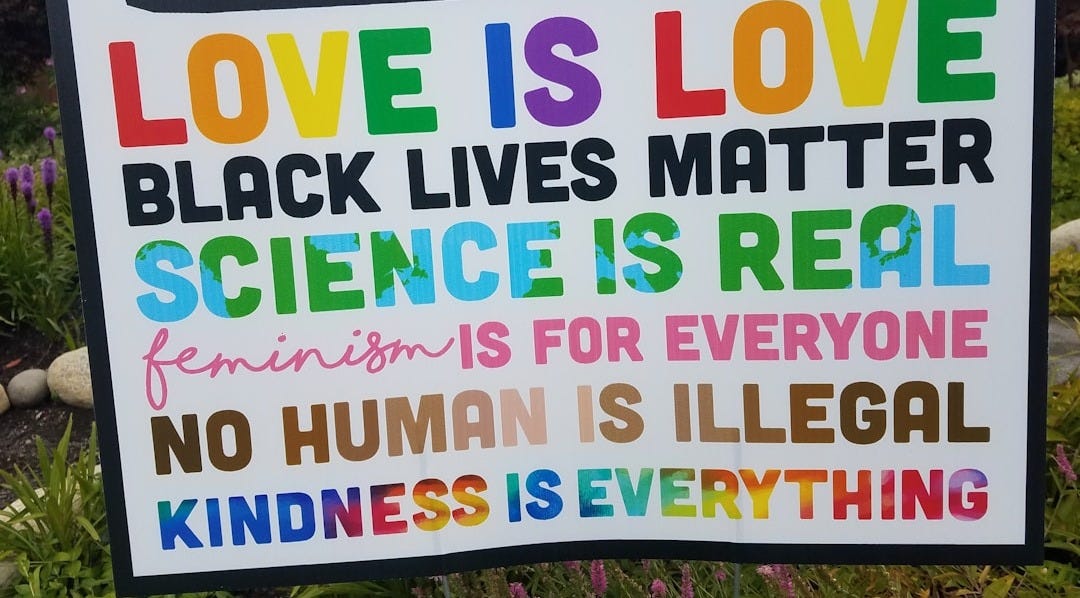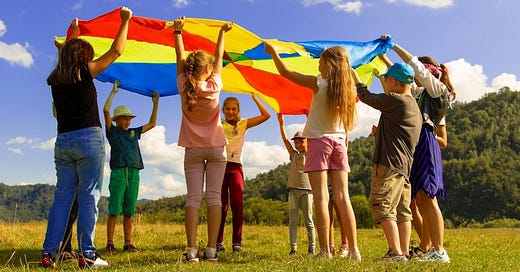SEL and DEI: Essential for every child's education
Advocating for children as a parent, professional, and citizen
In my city, families with entering Kindergarteners can research and tour nine elementary schools before submitting preferences through a “controlled choice” system. Choosing a school with a strong record of effective social-emotional learning (SEL)1 was a top priority for my husband and me. Equally important was being part of a school community that promotes diversity, equity, and inclusion (DEI)2. Both SEL and DEI are being challenged and defunded by the new administration, as they move to close the Department of Education. As a parent, and an educator, I am very concerned, but not surprised. Pushback against SEL and DEI are nothing new.
Our daughter’s elementary school uses evidence-based SEL programs, adapts them to the cultural context of the school, and provides additional targeted interventions for kids who need more. When our daughter has struggled with friendships and peer conflicts, the school was proactive about pulling a few kids together for a “lunch bunch” with a social worker, which helped. When a teacher at the school tragically died from a sudden medical emergency, the community came together under the guidance of trained mental health professionals to support children, families, and educators who were processing the news and grieving. More importantly, our child’s daily life at school includes ongoing opportunities to reflect on social-emotional themes simultaneously with her academics. I can’t imagine why any parent wouldn’t want SEL to be a strong and effective component of their child’s school life.

According to the recent “Frequently Asked Questions About Racial Preferences and Stereotypes Under Title VI of the Civil Rights Act”3 issued by the U.S. Department of Education’s Office for Civil Rights, SEL threatens children’s rights and equality. The document claims that “…schools have sought to veil discriminatory policies with terms like ‘social-emotional learning’ or ‘culturally responsive’ teaching.” SEL has faced pushback for decades from those who believe that anything outside of narrowly defined academic instruction is an encroachment on the role of the family. They don’t want teachers to make their children more empathetic to people who are different from them, like my LGBTQ+ family. It’s always been political, and for me, it’s personal. I don’t want your child to have the right to attend a public school in this country without learning how to play nicely on the playground with my child. Banning SEL makes it more acceptable for your kid to tease mine for having two dads, because respect, inclusion, and diversity are not part of the curriculum.
My own research4 has examined the ways that teachers bring culturally responsive SEL to life in the classroom through daily teaching practices and positive behavioral interventions. I find that the best teachers can integrate all of these priorities while delivering high-quality academic lessons and keeping their focus on the content. As a parent, I also want my own child’s teachers to do all of these things, not just some of them:
Build my child’s literacy skills (reading, writing, speaking, listening) - and that includes strengthening her cross-cultural proficiency.
Help her love math and be curious and confident with challenging work - part of which is to express thinking and critique the reasoning of others.
Teach my child how to follow instructions and work with a fair, effective leader- and also know how to challenge authority, participate in a democracy, and stand up for justice.
Express her feelings, validate her experiences — and also self-regulate and using coping skills to practice self-control.
See how human beings can do two things at once? Isn’t that the beauty of the education and development of children?
My colleagues and I conducted survey research in 2016-175 to investigate this intersection between SEL and culturally responsive practices. At the time, our participants reported that SEL was facing critiques because it was not incorporating enough diversity, equity, inclusion, and cultural responsiveness. Educators were looking for SEL to place DEI more at the center of its frameworks, particularly in the preparation of teachers6. Historically, SEL has not addressed DEI well, as articulated by Dena Simmons7, a national expert at the intersection of SEL, racial justice, and healing:
In recent years, that evolution has taken place in the field, as exemplified by the Transformative SEL8 framework. As a researcher and practitioner looking at the interplay between various theories, this is exactly what I was looking for and seeking to capture in my research several years ago, before there was a name and coherent vision for it. In a new text about Transformative SEL, the authors address how important and challenging this new approach to SEL can be:
…while SEL is meant to be used as a way of enhancing education, if teachers themselves don’t approach this work with a critical eye and a true appreciation of all students’ backgrounds and cultures, SEL can often be implemented as a tool to “fix” students who don’t conform to White, Eurocentric norms. In other words, rather than celebrating a student’s strengths and seeking ways of further supporting them, when students are viewed with a deficit-based mindset (e.g., focusing primarily on students’ weaknesses), SEL can even be weaponized as a way to get students to simply conform, rather than to thrive.9
It’s no surprise to me that politicians and elected officials who will fight any hint of racial justice or inclusivity are now challenging SEL. They are correct that SEL will help students communicate better with a diverse population and instill a sense of social justice. It scares them and threatens their vision of an authoritarian dictatorship. There are now conspiracy theories circulating about how SEL has roots in “occult religions.” It’s an act of desperation, resorting to fear tactics and appealing to a moral panic among people who want to stop their children (and my child) from developing healthy emotional lives and identities.

The confusion I feel about these challenges to SEL leads to curiosity, too. I try to put myself in the shoes of a parent worried that their child will be indoctrinated by a system that’s beyond their control. What it must feel like to worry that my children’s beliefs might turn out different from my own. I feel all of that, too. Growing up in the 1990s and attending public school in a southern state, I was constantly receiving implicit and explicit messages that my LGBTQ+ identity was unacceptable. Now, as a parent, I would be alarmed to learn that these kinds of messages were being delivered to my child without my consent, through approved curricula at school. I would take action. I’m trying to take the perspective of people on the other side and have empathy for them. That’s part of social-emotional learning and civic discourse. Unfortunately, those who oppose SEL and DEI won’t do the work needed to see things from my family’s point of view.
Collaborative for Academic, Social, and Emotional Learning (CASEL) (n.d.). Fundamentals of SEL. Retrieved March 17, 2025, from https://casel.org/fundamentals-of-sel.
Lawyers for Civil Rights Boston (n.d.). Diversity, Equity and Inclusion (DEI) in Massachusetts Public Schools: A Legal and Practical Guide for Implementing Principles of Diversity, Equity and Inclusion in Public School Settings. Retrieved March 20, 2025, from https://lawyersforcivilrights.org/
U.S. Department of Education’s Office for Civil Rights (2025, February 28). Frequently Asked Questions About Racial Preferences and Stereotypes Under Title VI of the Civil Rights Act. Retrieved March 17, 2025, from https://www.ed.gov/media/document/frequently-asked-questions-about-racial-preferences-and-stereotypes-under-title-vi-of-civil-rights-act-109530.pdf
Cressey, J. M. (2020). Culturally Responsive Social-Emotional Learning: Reframing Classroom and Behavior Management for Equity. In A. Singh, M. Viner, & R. Yeh (Eds.), Special Education Design and Development Tools for School Rehabilitation Professionals. Hershey, PA: IGI Global.
Cressey, J. “Social-Emotional Learning in Teacher Education: A Needs Assessment Survey of Teacher Educators.” Presentation given to the Massachusetts Consortium for Social-Emotional Learning in Teacher Education, Tufts University, Medford MA, March 2017.
Donohue-Keegan, D., Villegas-Reimers, E., & Cressey, J. (2019). Integrating Social-Emotional Learning and Culturally Responsive Teaching in Teacher Preparation Programs: Progress and Potential in Massachusetts. Teacher Education Quarterly 46(4), 150-168.
Simmons, D. (2021). Why SEL alone isn’t enough. Educational Leadership, 78, 30–34.
Collaborative for Academic, Social, and Emotional Learning (CASEL) (n.d.). Transformative SEL. Retrieved March 17, 2025, from https://casel.org/fundamentals-of-sel/how-does-sel-support-educational-equity-and-excellence/transformative-sel/
Soutter, M., Ward, A. E., & Ly, C. N. (2025). Transformative Social and Emotional Learning: Centering Equity and Social Justice in Pre-K-6 Classrooms. Teachers College Press. https://www.tcpress.com/transformative-social-and-emotional-learning-9780807787069




